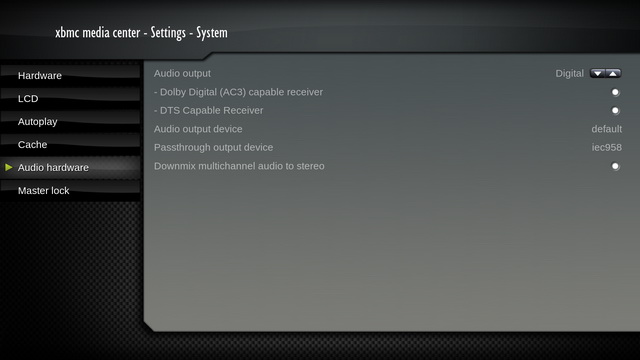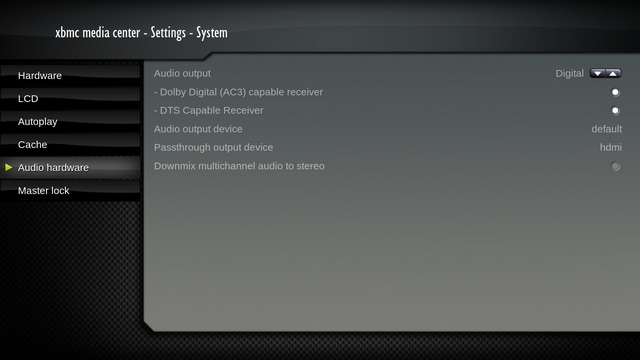Archive:HOW-TO:Install XBMC on Ubuntu/HOW-TO 2

|
THIS PAGE IS OUTDATED:
This page or section has not been updated in a long time, no longer applies, refers to features that have been replaced/removed, and/or may not be reliable. This page is only kept for historical reasons, or in case someone wants to try updating it. |
A more updated minimal install article is XBMCbuntu.
The purpose of this guide is to give a helping hand to those users who are completely new to XBMC Media Center and Linux, and users who still want to build a Linux based, dedicated HTPC (Home Theater PC), in a true living-room media center computer setup, but do not have any knowledge and experience about the Linux world.
You always have the chance to try XBMC Live to demo and test out XBMC Media Center running on top of Linux, but if you want to have more control and more customization possibilities, then a Linux installation like described in this guide might be more suitable.
In case you have any issues/ questions and comments, feel free to visit this forum thread
Introduction
This is a real step-by-step guide, I hope everybody can follow and walk through the whole installation procedure. The guide is based on either Ubuntu 8.04 (Hardy Heron), 8.10 (Intrepid Ibex), or 9.04 (Jaunty Jackalope) as a platform, start with a minimal install and only install the needed components on the top of that.
On the face of it, this guide may seem like a very lengthy process, but it will feel much shorter while you begin following it step-by-step.
Please note:
- The guide is for using XBMC on a dedicated HTPC, so there is no window manager and/ or any additional applications installed.
- You need minimum 4GB size Flash drive or harddisk drive to install on.
- Since you will use this PC only as a media center. I therefor assume that you use digital audio pass-through (S/PDIF or HDMI) to a receiver/amplifier with built-in Dolby Digital (AC3) decoder, and hence I choose NOT to install the dependency libraries for PulseAudio and compile XBMC later without PulseAudio support.
- Please be aware, if you are installing a full Ubuntu OS with GDM, then the guide will not fully applicable!
- Please also think twice, if you want to use any of the below sections in it's own, without following the guide step-by-step from the begining
You will get:
- A dedicated HTPC which auto-boots directly to XBMC Media Center.
- Latest XBMC SVN version.
- Upgraded ALSA (audio) driver.
- Up to date VIDEO (graphics) driver.
- LIRC (Microsoft MCE Remote will work out-of-the-box, however if you have any other remotes and/or LCD displays then you are on your own to solve the individual LIRC and LCDproc issues).
- Suspend/resume (works perfectly for example with ASUS P5N7A-VM motherboard using Intrepid).
Known issues:
- Installations based on Intrepid and Jaunty having video playback performance issues due to an unidentified root cause. You can read more about that in this forum thread.
- You might have some difficulties with suspend/ resume on Hardy based installations
- Mouse cursor is appearing in the middle of the screen after resume on Jaunty
Preparation
FIRST STEP
Download and burn Ubuntu Hardy/ Intrepid/ Jaunty mini.iso (according to your platform preference) from here:
https://help.ubuntu.com/community/Installation/MinimalCD
Please be aware, if you are choosing to install a full-blown Ubuntu OS with GDM instead of the minimal install, then this guide is not fully applicable!
Now perform a default install.
- please set „xbmc” for username and also for password when asked during the installation
- When you have the option to choose from the optional components during the installation, check only „OpenSSH” to be able to access your HTPC remotely later via SSH.
In case you are using a flash drive (aka. pendrive, usb drive) and choosed Intrepid as base platform, you will facing with a bug in Intrepid installer. In this case the installer won't installing GRUB for some reason.
This is only affect Intrepid, and only when you are installing on a flash drive.
As a workaround, you have to install Hardy(Ubuntu 8.04) mini.iso first, which is installing GRUB correctly, then immedietly after that, install Intrepid mini.iso over the same flash drive. It will reformat the drive, but GRUB will stay alive on the drive.
Once you finsihed the installation, boot up, then use an SSH application (e.g. putty) to log in remotely from your desktop using the above created username and password. This way, you will be able to copy/ paste all the steps below. Alternatively you can use the console of the htpc itself too, but then you will have a hard time typing in everything.
So once you logged in:
First of all you need to install all XBMC prerequisites:
NEXT STEP Hardy - Skip this and jump to NEXT STEP Intrepid/ Jaunty, if you are installing Intepid or Jaunty
# sudo apt-get --purge autoremove -y nvidia-kernel-common linux-restricted-modules-generic linux-restricted-modules-common linux-restricted-modules-2.6.24-23-generic
NEXT STEP Hardy - Skip this and jump to NEXT STEP Intrepid/ Jaunty, if you are installing Intepid or Jaunty
# sudo apt-get install -y linux-headers-generic localepurge subversion make g++ gcc gawk pmount libtool nasm automake cmake gperf unzip bison libsdl1.2-dev libsdl-image1.2-dev libsdl-gfx1.2-dev libsdl-mixer1.2-dev libsdl-sound1.2-dev libsdl-stretch-dev libfribidi-dev liblzo-dev libfreetype6-dev libsqlite3-dev libogg-dev libasound-dev python-sqlite libglew-dev libcurl4-gnutls-dev x11proto-xinerama-dev libxinerama-dev libxrandr-dev libxrender-dev libmad0-dev libtre-dev libogg-dev libvorbis-dev libmysqlclient15-dev libpcre3-dev libdbus-1-dev libhal-dev libhal-storage-dev libjasper-dev libfontconfig-dev libbz2-dev libboost-dev libfaac-dev libenca-dev libxt-dev libxmu-dev libpng12-dev libjpeg-dev mesa-utils libcdio-dev wget zip curl hal build-essential linux-headers-`uname -r` xorg pm-utils
NEXT STEP Intrepid/ Jaunty
# sudo apt-get install -y localepurge subversion make g++ gcc gawk pmount libtool nasm automake cmake gperf unzip bison libsdl1.2-dev libsdl-image1.2-dev libsdl-gfx1.2-dev libsdl-mixer1.2-dev libsdl-sound1.2-dev libsdl-stretch-dev libfribidi-dev liblzo-dev libfreetype6-dev libsqlite3-dev libogg-dev libasound-dev python-sqlite libglew-dev libcurl4-gnutls-dev x11proto-xinerama-dev libxinerama-dev libxrandr-dev libxrender-dev libmad0-dev libtre-dev libogg-dev libvorbis-dev libmysqlclient-dev libpcre3-dev libdbus-1-dev libhal-dev libhal-storage-dev libjasper-dev libfontconfig-dev libbz2-dev libboost-dev libfaac-dev libenca-dev libxt-dev libxmu-dev libpng12-dev libjpeg-dev mesa-utils libcdio-dev wget zip curl build-essential linux-headers-`uname -r` xorg xserver-xorg-dev pm-utils
During the installation of the packages, there will be a popup window to choose your locale languages to let "localepurge" know which locales not to remove in further installations. I would suggest to keep all en_us (3 all together) and your own country locales (again should be 3) as well. Localepurge will save you some space with removing unneccessary languages.
Upgrading ALSA (sound driver) to the latest version
To download and use the upgrade script:
NEXT STEP
# wget http://217.20.138.65/xbmc/AlsaUpgrade-1.0.x-rev-1.16.sh
NEXT STEP
# chmod a+x AlsaUpgrade-1.0.x-rev-1.16.sh
NEXT STEP
# sudo ./AlsaUpgrade-1.0.x-rev-1.16.sh -di
If you are on Intrepid or Jaunty, you have to add your user (the one you've created during the installation) to the „audio” group (you don't need to do that in case of Hardy).
NEXT STEP
# sudo usermod -a -G audio xbmc
(Please note: replace „xbmc” with username you've installed with)
You also have to edit the following file to make spdif and/or hdmi work properly:
NEXT STEP Hardy/ Intrepid - Skip this and jump to NEXT STEP Jaunty, if you are installing Jaunty
# sudo nano /etc/modprobe.d/alsa-base
NEXT STEP Jaunty
# sudo nano /etc/modprobe.d/alsa-base.conf
and add (copy/ paste) this line to the last line of the file:
options snd-hda-intel model=6stack-dig
NEXT STEP
reboot the computer:
# sudo reboot
Delete the just downloaded ALSA source to free up some disk space:
NEXT STEP
# sudo rm -r /usr/src/Alsa-1.0.19/
Now run alsamixer:
NEXT STEP
# alsamixer
Navigate right with cursor keys until IEC958 and unmute all three of them (IEC958) with „M” key. You should see in case of all three IEC958 a „00” in green background. Press „ESC” to quit from alsamixer.
Update Video driver
These update methods are only applicable for those, who are following the guide step-by-step from the begining. Do not use these at any circumtances in case you have installed full-blown Ubuntu OS with GDM, instead of the minimal one!!!
Nvidia
(For Ati owners: jump to #Ati)
NEXT STEP
# wget ftp://download.nvidia.com/XFree86/Linux-x86/185.18.08/NVIDIA-Linux-x86-185.18.08-pkg1.run
NEXT STEP
# sudo sh NVIDIA-Linux-x86-185.18.08-pkg1.run
Within nvidia installer: accept the License agreement, choose „YES” for „No precompiled kernel interface...”, choose „OK” for „No matching precompiled kernel interface...”, choose „YES” again to update X configuration file, then a final „OK” again at the end.
Now you can delete Nvidia installer:
NEXT STEP
# rm NVIDIA-Linux-x86-185.18.08-pkg1.run
xorg.conf configuration (Nvidia)
If you want Xorg autodetect the native resolutions of your display from EDID and want to use 24p, you have to replace your xorg.conf with this one(not guaranteed to work, but should with newer Nvidia cards):
NEXT STEP
# sudo cp /etc/X11/xorg.conf /etc/X11/xorg.conf.backup
NEXT STEP
# sudo wget http://217.20.138.65/xbmc/xorg.conf -O /etc/X11/xorg.conf
(To continue click on: #Download, compile, and install XBMC from source (skip section Ati))
Ati
NEXT STEP
# sudo apt-get install -y cdbs fakeroot dh-make debhelper debconf libstdc++5 dkms
NEXT STEP
# wget http://www2.ati.com/drivers/linux/ati-driver-installer-8-12-x86.x86_64.run
NEXT STEP
# sudo sh ati-driver-installer-8-12-x86.x86_64.run --buildpkg Ubuntu/intrepid
NEXT STEP
# sudo dpkg -i xorg-driver-fglrx_8.561-0ubuntu1_i386.deb fglrx-kernel-source_8.561-0ubuntu1_i386.deb fglrx-amdcccle_8.561-0ubuntu1_i386.deb
NEXT STEP
# rm ati-driver-installer-8-12-x86.x86_64.run *.deb
xorg.conf configuration (Ati)
Will be discussed later, stay tuned
Download the source from SVN, compile, and install XBMC
To download from SVN:
NEXT STEP
# svn checkout http://xbmc.svn.sourceforge.net/svnroot/xbmc/trunk/ ./XBMC
In case of Hardy, you will get a certificate warning, accept it permanetly by pressing „P”.
Wait until downloading XBMC source files finished. That might take long time, depending on your Internet connection.
NEXT STEP
# cd XBMC
Then configure, compile, and install XBMC:
NEXT STEP
# ./configure --prefix=/usr --disable-pulse
NEXT STEP
# make -j2 (Please note: use only „make”, if you don’t have a dualcore CPU)
This is again, can take quite some time, depending on your CPU speed.
NEXT STEP
# sudo make install
Autoboot to XBMC
This autoboot method is strictly for use with non-GDM installations, do not use this at any circumtances in case you have installed full-blown ubuntu OS with GDM!!! Again, this is especially for those who are following the guide step-by-step from the begining!!!
NEXT STEP
# sudo wget http://pastebin.com/pastebin.php?dl=f21151817 -O /etc/init.d/xbmc
NEXT STEP
# sudo chmod a+x /etc/init.d/xbmc
NEXT STEP
# sudo update-rc.d -f xbmc defaults
NEXT STEP
# sudo wget http://pastebin.com/pastebin.php?dl=f3e5057bd -O /usr/bin/runXBMC.sh
If you not choose "xbmc" as your user at the installation, you have to modify this file according to your username.
NEXT STEP
# sudo chmod a+x /usr/bin/runXBMC.sh
NEXT STEP
# sudo dpkg-reconfigure x11-common
Choose "anybody" to run X. Leave the other question on default.
Install Lirc
MS MCE Remotes - listed here: http://www.mythtv.org/wiki/MCE_Remote - are working plug & play out of the box. So in case you own one of the above mentioned MS MCE remotes, the installation is that simple:
NEXT STEP
# sudo apt-get install -y lirc
And follow the lirc installation wizard.
Power Management
To have control over power related functions (suspend, shutdown, reboot) from within XBMC, you have to modify PolicyKit.conf to grant privilegies to your user for power management. There is a preprepared PolicyKit.conf for this. You can get it by:
NEXT STEP
# sudo wget http://217.20.138.65/xbmc/PolicyKit.conf -O /etc/PolicyKit/PolicyKit.conf
Please note: if you installed your system with username other than "xbmc" during the installation, you have to modify the file according to the username.
If you wish to enable CPU scaling, install the required package below, but don’t forget to enable it in the BIOS as well.
NEXT STEP
# sudo apt-get install powernowd
Install Splash
You may want to have a look at du-duke's fantastique splash screens. You can check these here: http://du-duke.blogspot.com/ You can download your choice below.
NEXT STEP
# sudo apt-get -y install usplash libusplash-dev
NEXT STEP Hardy - Skip this and jump to NEXT STEP Intrepid or Jaunty, if you are installing Intepid or Jaunty
# sudo apt-get -y install usplash-theme-ubuntu
NEXT STEP Hardy - Skip this and jump to NEXT STEP Intrepid or Jaunty, if you are installing Intepid or Jaunty
CHOICE 1 - Downloading spinner-blue
# sudo wget http://217.20.138.65/xbmc/splash/usplash-spinner-hardy.so -O /usr/lib/usplash/usplash-theme-ubuntu.so
NEXT STEP Hardy - Skip this and jump to NEXT STEP Intrepid or Jaunty, if you are installing Intepid or Jaunty
CHOICE 2 - Downloading pulsating-logo
# sudo wget http://217.20.138.65/xbmc/splash/usplash-pulsating-hardy.so -O /usr/lib/usplash/usplash-theme-ubuntu.so
NEXT STEP Intrepid - Skip this and jump to NEXT STEP Jaunty, if you are installing Jaunty
CHOICE 1 - Downloading spinner-blue
# sudo wget http://217.20.138.65/xbmc/splash/usplash-spinner-intrepid.so -O /usr/lib/usplash/usplash-theme-ubuntu.so
NEXT STEP Intrepid - Skip this and jump to NEXT STEP Jaunty, if you are installing Jaunty
CHOICE 2 - Downloading pulsating-logo
# sudo wget http://217.20.138.65/xbmc/splash/usplash-pulsating-intrepid.so -O /usr/lib/usplash/usplash-theme-ubuntu.so
NEXT STEP Jaunty
CHOICE 1 - spinner-blue
# sudo wget http://217.20.138.65/xbmc/splash/usplash-spinner-jaunty.so -O /usr/lib/usplash/usplash-theme-ubuntu.so
NEXT STEP Jaunty
CHOICE 2 - Downloading pulsating-logo
# sudo wget http://217.20.138.65/xbmc/splash/usplash-pulsating-jaunty.so -O /usr/lib/usplash/usplash-theme-ubuntu.so
NEXT STEP
# sudo nano /etc/usplash.conf
and set your desired splash resolution, so inserting the following to here.
(Please note: this is a FullHD example):
xres=1920
yres=1080
NEXT STEP
# sudo update-initramfs -u
Enable thermal monitoring
To install the necessary package:
# sudo apt-get install -y lm-sensors
Once lm-sensors installed, you have to run sensor detection to identify your sensors:
# sudo sensors-detect
There will be a lot of questions here, but you can answer by "enter" key to all of them except the last question which is "Do you want to add these lines automatically?" At here, you have to type "yes", then enter..
Reboot the computer:
# sudo reboot
After rebooted, check if the sensors are working:
# sensors -u
You should see the output of the sensors here.
XBMC CPU temp detection
To let XBMC detect your CPU temps provided by lm-sensors, you have to edit your advancedsettings.xml and insert the following:
<advancedsettings> <cputempcommand>sensors|sed -ne "s/Core 1: \+[-+]\([0-9]\+\).*/\1 C/p"</cputempcommand> </advancedsettings>
XBMC GPU (nvidia) temp detection
To let XBMC detect your GPU temps provided by nvidia-settings, you have to edit your advancedsettings.xml and insert the following:
<advancedsettings> <gputempcommand>echo "$(nvidia-settings -tq gpuCoreTemp) C"</gputempcommand> </advancedsettings>
Enable eject button of your ODD
# sudo nano /etc/sysctl.conf
and uncomment or add (by deleting # from the beginning of the line) the last line, so it will look like this:
dev.cdrom.lock=0
Reduce boot time
reduce GRUB waiting (~2 sec)
# sudo nano /boot/grub/menu.lst
Find the timeout (currently set to 3) and change this to 0
Reduce the number of loaded vts
vts=(virtual terminal service)
By default, they're F1 through F7, we don't need that much for a HTPC, so we can remove most of them.
# sudo nano /etc/event.d/tty3
and comment out all the lines, using #. Repeat the above command for tty4-tty6, so at the end you've deactivated 3 vts's.
BIOS OEM Splash screen
Recent motherboards usually featured with the possibility to change to BIOS OEM logo. Below you can find two modified XBMC logo. The format and size of the picture has been modified to fit into the BIOS (ASUS P5N7A-VM), there is no guarantee to work with any other motherboard, but I guess it should work with all boards with newer AMI bioses.
BE AWARE! Nobody take responsibility if you brick your motherboard while playing with BIOS.
In case of ASUS, you can do it with MyLogo2, which is a bundled tool for your MB.
The aspect ratio of the picture is like this for purpose. When your BIOS displays it, it will stretch to fit to the screen. So this is made for 16:9 (not for 4:3, and nor for 16:10)
Wake On Lan
# sudo apt-get install -y ethtool
# sudo nano /etc/init.d/wol.sh
Copy the following text into it, then save the file:
ethtool -s eth0 wol g
Make this newly created script executable:
# sudo chmod a+x /etc/init.d/wol.sh
Make it start during boot:
# sudo update-rc.d -f wol.sh defaults
Sound configuration in XBMC
After booted into XBMC switch to „digital” audio output, than choose the AC3 and DTS capabilities according to your receiver.
For SPDIF:
Leave audio output device: default
Leave passthrough to IEC958

For HDMI:
To have analog and navigation sound working:
# sudo nano /etc/asound.conf
and insert the following lines:
pcm.!default {
type plug
slave {
pcm "hdmi"
}
then save the file.
In xbmc change audio output device to hdmi
Change passthrough to hdmi

MythTV
You may want to have a look at this MythTV article here (link)

